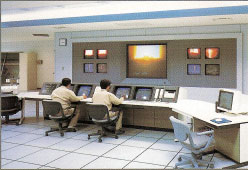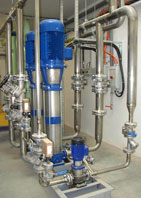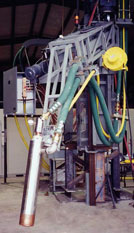Phoenix Solutions Co Plasma Heating Technology was originally developed to simulate the heat of hypersonic orbital re-entry in wind tunnels. The intense, direct heat of plasma is used today in waste remediation, metallurgical applications and, more recently, in the processing of waste feedstocks into renewable synthetic fuel, or biogas. Phoenix Solutions' Plasma Arc Torch systems are the cutting edge of proven plasma technology, providing reliable performance worldwide. Each PSC Plasma Heating System consists of the following equipment:
Plasma Arc Torch
Available in transferred, non-transferred and convertible arc designs, PSC Plasma Arc Torches operate on virtually any gas mixture.
Process Furnace
The Process Furnace is the vessel in which the plasma torch operates. Our expansive knowledge of plasma heating, combined with the legacy of FluiDyne Engineeing Corp as an industry leader in furnace design, makes us uniquely qualified to design and fabricate custom furnaces.
 Current-Controlled
DC Power Supply
Current-Controlled
DC Power Supply
Custom-designed and built to
specifications determined by our customer's application,
Phoenix Solutions employs DC Power Supplies built by Sansha/SanRex, SatCon
and I.E. Power.

HMI Contol System
Phoenix utilizes Cimplicitiy Software's cutting-edge Human-Machine Interface (HMI) software. PSC custom programs every system, tailoring the controls and user-interface to the needs of each customer.
 Water/Gas
Manifold
Water/Gas
Manifold
The Water/Gas Manifold provides a central point to analyze and control the supply of torch cooling water and operating gas. It is custom-designed for each installation and built of high-grade stainless steel. To monitor cooling water and operating gas, PSC relies on top-of-the-line gauges and instruments from Sierra Instruments and Yokogawa.
DC LEP or High Frequency Starting System
Phoenix Solutions has developed both DC Low Energy Pulse (LEP) and High-Frequency starting systems for our full range of plasma arc torches.
 Torch
Manipulation System
Torch
Manipulation System
PSC works with every client to custom-design a Torch Manipulation System that meets the specific requirements for each environment and application. The controls for the manipulator are integrated into the HMI, giving operating technicians a single point of control over the entire system.

